
QQQX
نزدک
| تریدر | نوع سیگنال | حد سود/ضرر | زمان انتشار | مشاهده پیام |
|---|---|---|---|---|
 AnabelSignalsرتبه: 159 | فروش | حد سود: تعیین نشده حد ضرر: تعیین نشده | ۱۴۰۴/۹/۳۰ | |
 UnitedSignalsرتبه: 374 | خرید | حد سود: تعیین نشده حد ضرر: تعیین نشده | ۱۴۰۴/۹/۲۲ | |
 RonnieV29رتبه: 1067 | خرید | حد سود: تعیین نشده حد ضرر: تعیین نشده | ۱۴۰۴/۹/۲۸ | |
cryptoyoda1رتبه: 1030 | خرید | حد سود: تعیین نشده حد ضرر: تعیین نشده | ۱۴۰۴/۹/۲۵ | |
 ContraryTraderرتبه: 2796 | خرید | حد سود: تعیین نشده حد ضرر: تعیین نشده | ۱۴۰۴/۹/۱۶ |
نمودار قیمت نزدک
سود ۳ ماهه :
سیگنالهای نزدک
فیلتر
مرتب سازی پیام براساس
نوع پیام
نوع تریدر
فیلتر زمان

UA_CAPITAL
QQQ (NQ-US100) Weekly Prediction – Outlook (21 DEC)
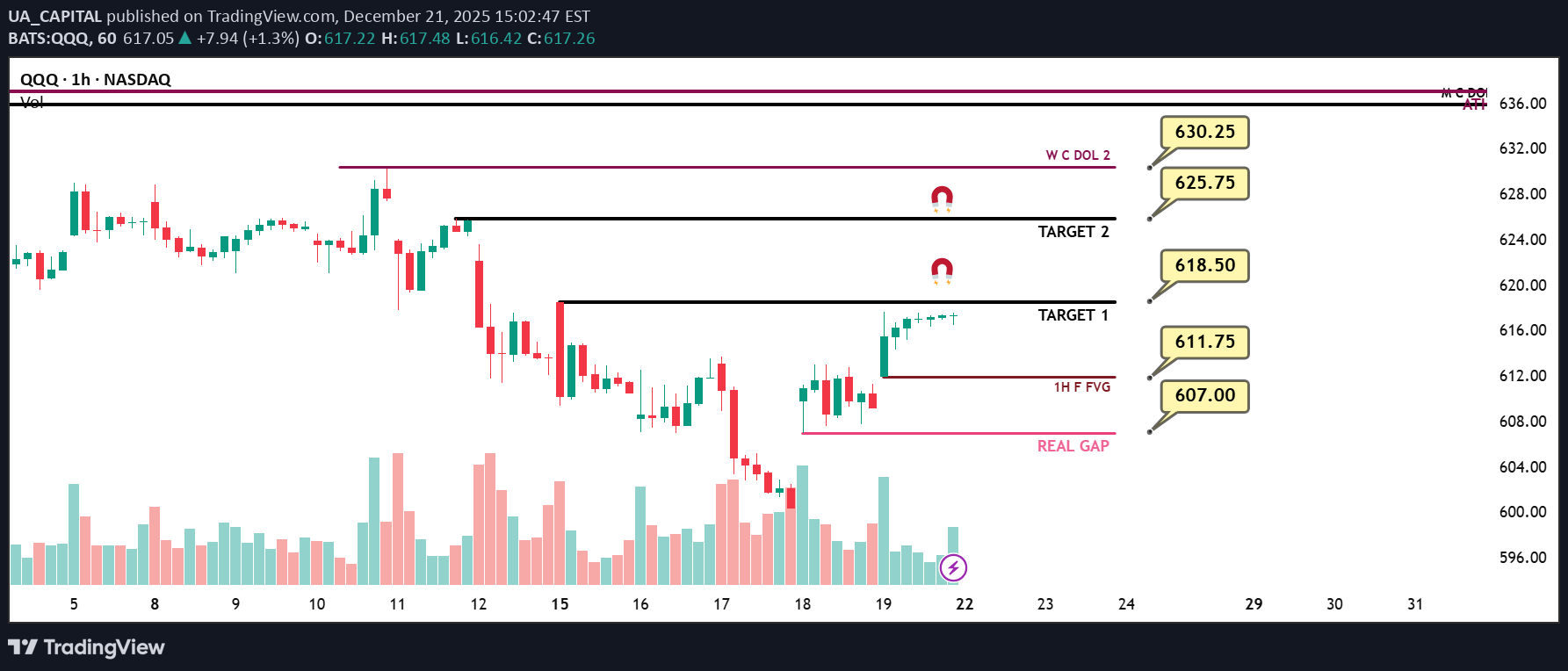
پیشبینی هفتگی QQQ (NQ-US100) - چشمانداز (21 دسامبر) 📊 احساسات بازار پس از اینکه CPI data به طور قابل توجهی کمتر از حد انتظار در روز پنجشنبه بود، احساسات بازار کاملاً صعودی شد. در حالی که انتظار اجماع 3.1٪ بود، چاپ واقعی CPI به 2.7٪ رسید که نشان دهنده یک شگفتی نزولی معنی دار است. این data مستقیماً نتیجه جلسه ژانویه FED را تعیین نمی کند، زیرا گزارش CPI دیگری در 13 ژانویه 2026 منتشر شد که برای فرآیند تصمیم گیری FED بسیار مهم تر بود. با این حال، روند ملایم تورم فعلی احتمال کاهش دوباره شاخص CPI را در ژانویه افزایش داد که به طور مثبت بر احساسات ریسک در سراسر بازارها تأثیر گذاشت. 📈 تحلیل فنی تجزیه و تحلیل QQQ هفته گذشته کاملاً انجام شد. امیدوارم توانسته باشید از آن بهره ببرید. قیمت دقیقاً از سطوحی که پس از انتشار CPI پیشبینی میکردیم معکوس شد. من تجزیه و تحلیل هفتگی QQQ هفته گذشته را برای مرجع در زیر پیوند می دهم. پس از داده های CPI، قیمت در هر دو بازه زمانی روزانه و هفتگی به یک ساختار صعودی تمیز بازگشت. در روز جمعه، QQQ به طور ناگهانی افزایش یافت و هفته را با حرکت صعودی قوی به پایان رساند. به طور کلی، من فکر می کنم ساختار بازار از ادامه روند صعودی حمایت می کند. 📌 طرح بازی من فکر می کنم که QQQ ممکن است مستقیماً 618.5 (هدف 1) را در اوایل هفته آزمایش کند و به دنبال آن یک move به سمت 625.75 قرار گیرد. این دو هدف صعودی هستند که انتظار دارم در این هفته به آنها برسم. قیمت همچنین ممکن است move به سمت این اهداف بدون هیچ گونه اصلاح معنی دار باشد. من قصد دارم یک سوم از گزینه های تماس خود را در 618.5 و قسمت باقی مانده را در 625.75 از موقعیت هایی که از پنجشنبه در اختیار دارم، ببندم. اگر قیمت قبل از رسیدن به 625.75 به 611.75 یا 607 برگردد و شمع صعودی قوی 1H یا 4H را چاپ کند، من به دنبال اضافه کردن موقعیت های گزینه تماس جدید با هدف قرار دادن 625.75 هستم. در صورت توسعه ساختار نزولی، به روز رسانی را ارائه کرد. با این حال، در این مرحله، من هیچ سیگنال نزولی واضحی نمی بینم. 💬 برای درک عمیقتر احساسات و استراتژی، در دسترسی رایگان Substack من مشترک شوید. این تجزیه و تحلیل فقط برای اهداف آموزشی است و به منزله مشاوره مالی نیست. همیشه قبل از معامله یا سرمایه گذاری تحقیقات خود را انجام دهید. هدف 1 کاملاً در فضای باز بود. همانطور که قبلاً گفتم 1/3 از موقعیت های تماس خود را به 618.5 فروختم. اکنون منتظر هستم تا ببینم آیا برای افزودن تماسهای بیشتر، با هدف قرار دادن 625.75، اصلاح و جهشی دریافت میکنیم. با این حال QQQ ابزار ضعیفتری در اینجاست، بنابراین SPY انتخاب بهتری برای موقعیتهای تماس است.
QQQ (19 December)
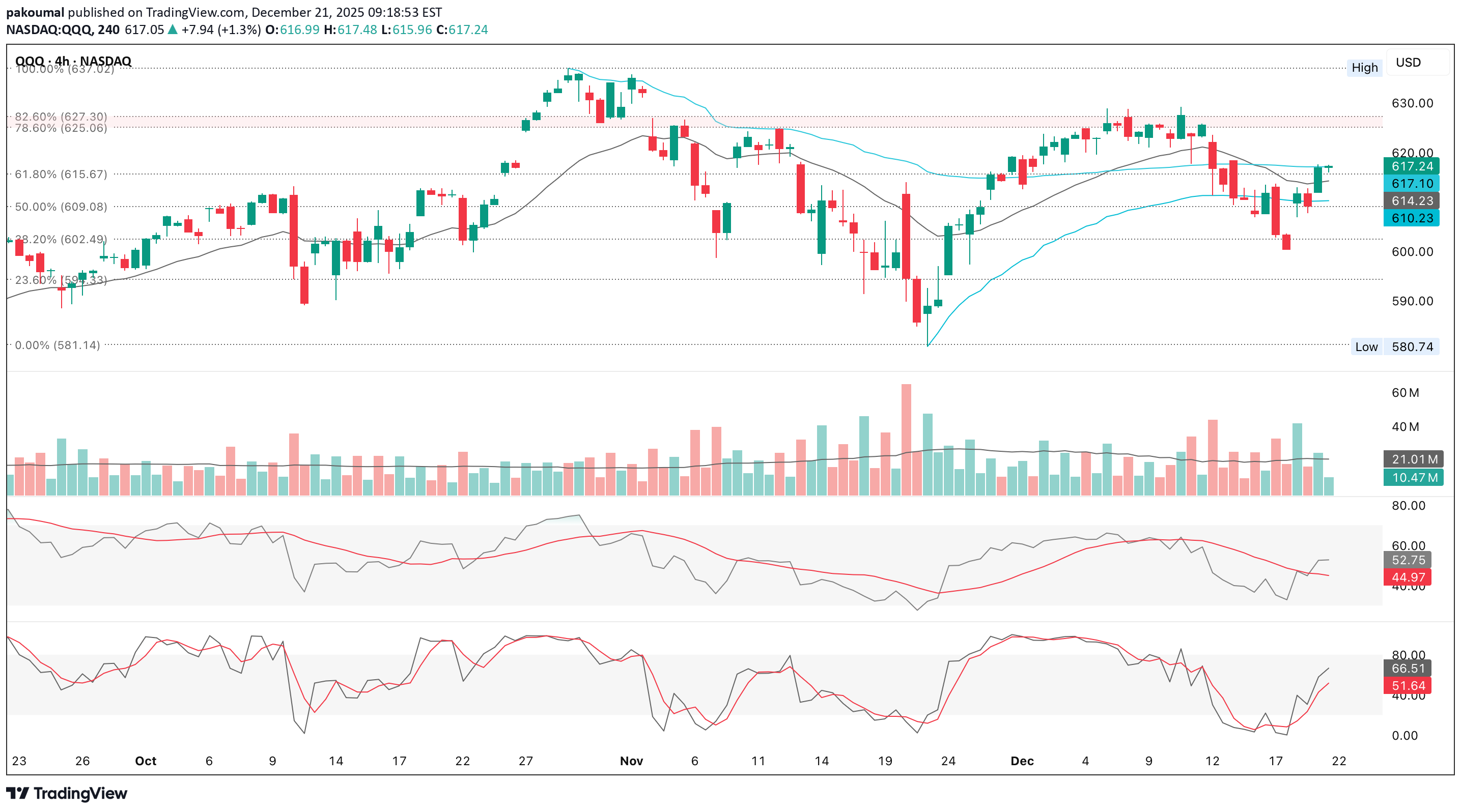
تا زمانی که QQQ 612 دلار نگه داشته باشد، ریسک نزولی در حال محو شدن است و پذیرش بالای 618 دلار، آن را از یک جهش به یک پایه تبدیل می کند. پایین ترین سطح از ~ 600 دلار تا ~ 612-615 دلار در حال شکل گیری است قیمت در بازههای زمانی بالاتر از ارزش بازیابی شده (612-615 دلار) باقی میماند این امر سناریوی شکست نزولی فوری را باطل می کند RSI شتاب ادامه صعودی است، نه بازگشت میانگین Stoch در بازههای زمانی پایینتر بیش از حد خرید میشود، اما سیگنال فروش نیست مگر اینکه قیمت پشتیبانی را بشکند. مومنتوم از قیمت حمایت می کند، نه اینکه در برابر آن واگرا شود افزایش حجم با افزایش 612 دلار بدون فروش سنگین حجم در مکث این خرید کنترل شده است، نه تنها پوشش کوتاه که قدرت جهش را افزایش می دهد 1. اکنون 615 دلار پشتیبانی حیاتی است و باید عقب نشینی را حفظ کرد اگر قیمت 615 دلار باشد، بازار در حال ایجاد یک پایه است 2. انتظار ریز کردن 618-620 دلار را داشته باشید رد کردن فقط در صورتی مهم است که قیمت به زیر 615 دلار بازگردد 3. 625 دلار اگر 620 دلار با پذیرش شکست بخورد، قیمت احتمالاً به سرعت در اینجا حرکت می کند این به شدت به نفع ادامه روند صعودی بود 4. از دست دادن 615 دلار، سپس از دست دادن 612 دلار، قیمت را دوباره به تعادل می رساند - هنوز روند شکست نمی خورد، اما برای تماس های کوتاه مدت بد است. تا زمانی که 615 دلار باقی بماند، صعودی ماندن موجه است بازار از خطر شکست جهش به ساختن یک پایگاه تغییر کرده است خرس ها کنترل خود را در 612 دلار از دست دادند گاوها برای پس گرفتن کامل آن به 620 دلار به بالا نیاز دارند اکنون بحث در مورد این است که آیا حرکت به اندازه کافی سریع دنبال می شود یا خیر

AnabelSignals
QQQ Trading Opportunity! SELL!
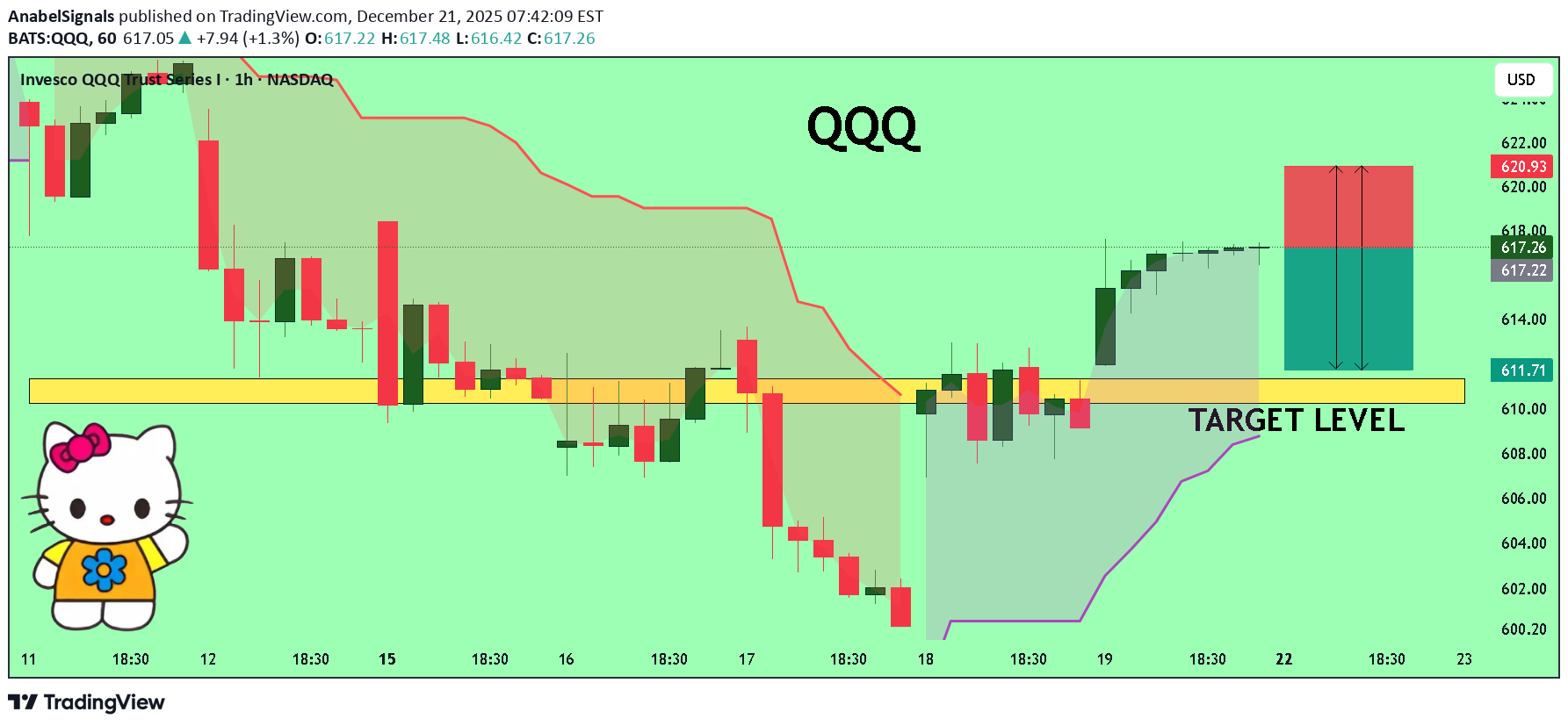
فالوورهای عزیزم این نظر من در مورد QQQ بعدی move است: دارایی به نقطه محوری مهم 617.26 نزدیک می شود تعصب - نزولی Safe توقف ضرر - 620.93 شاخص های فنی: Supper Trend یک سیگنال کوتاه واضح ایجاد می کند در حالی که Pivot Point HL در حال حاضر روند نزولی کلی بازار را تعیین می کند. هدف - 611.35 درباره شاخص های استفاده شده: برای سیگنالهای کارآمدتر، سوپر روند در ترکیب با شاخصهای دیگر مانند Pivot Points استفاده میشود. افشا: من بخشی از برنامه اینفلوئنسر Trade Nation هستم و برای استفاده از نمودارهای TradingView آنها در تجزیه و تحلیل خود، هزینه ماهانه دریافت می کنم. ——————————— برای همه شما آرزوی موفقیت دارم
Reading Market Intent vs Reacting to Price
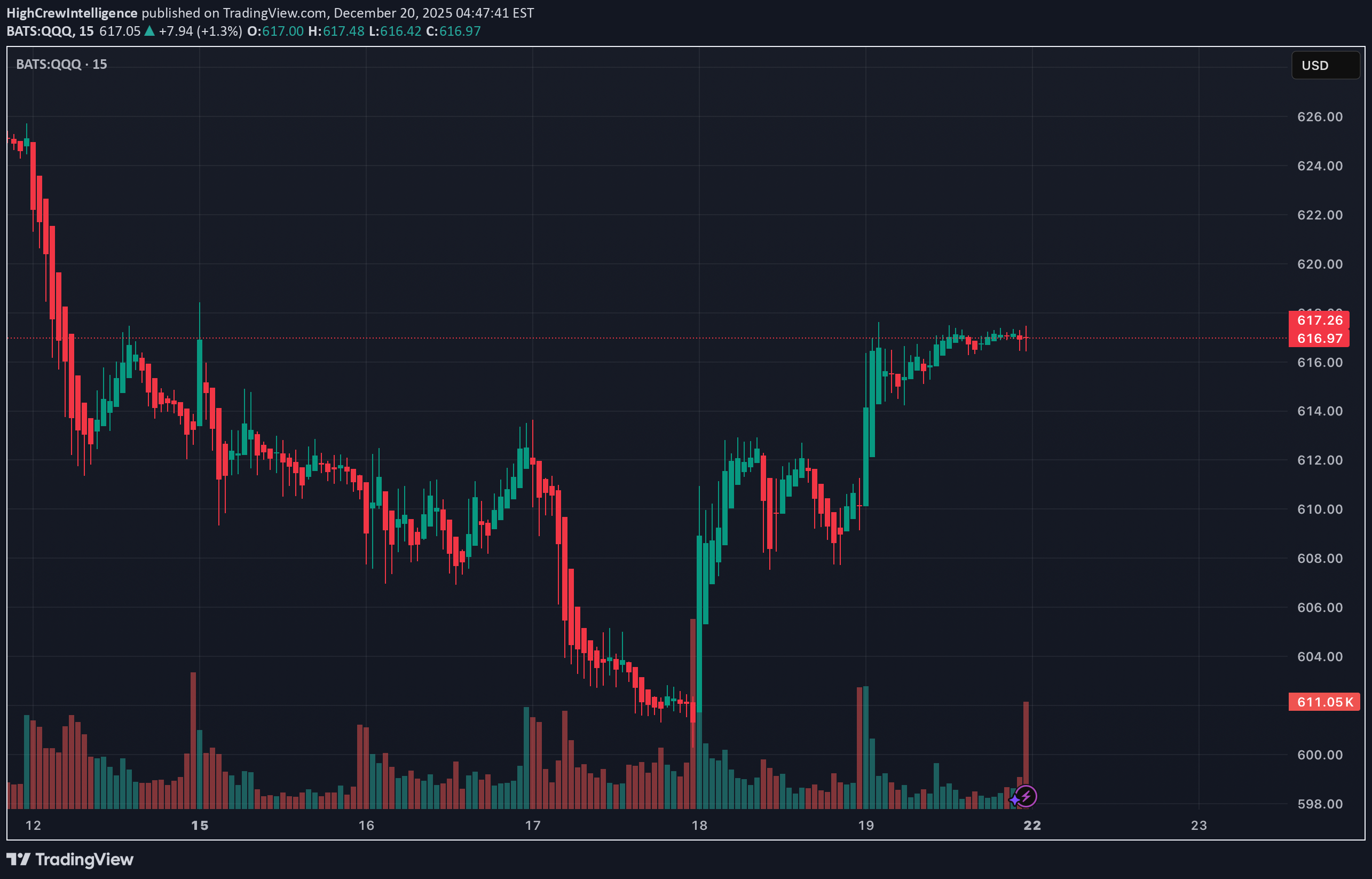
اکثر معامله گران به قیمت واکنش نشان می دهند. من روی قصد تمرکز می کنم، فشاری که قبل از واکنش قیمت ایجاد می شود. این فلسفه همان چیزی است که سیستم اطلاعاتی HIGHCREW پیرامون آن ساخته شده است. RSI Scout Edition موتور نیست. این یک لنز ساده شده است که وقتی تکانه در حال انبساط یا توقف است را برجسته می کند، بنابراین به جای واکنش نشان دادن، قصد قابل مشاهده می شود. این یکی از layer یک چارچوب اطلاعاتی گسترده تر است - سیستم های اضافی در طول زمان منتشر شد.
Global Equity Markets Under Pressure: Causes and Consequences
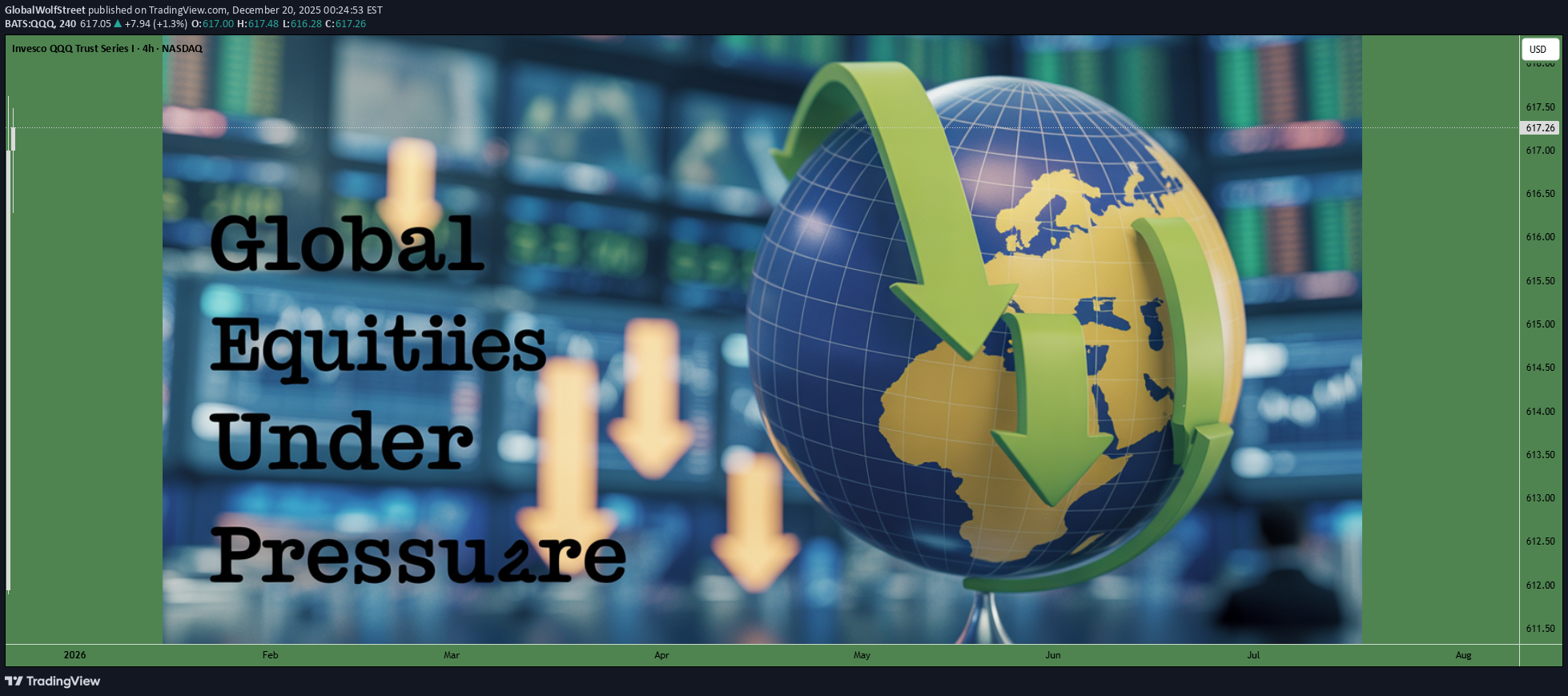
Macroeconomic Headwinds Driving Market Stress One of the primary reasons global equities face pressure is the challenging macroeconomic backdrop. High inflation, tighter monetary policy, and slowing economic growth often converge to create an unfavorable environment for stocks. Central banks, led by the US Federal Reserve and followed by institutions such as the European Central Bank and the Bank of England, tend to raise interest rates to control inflation. While necessary, higher interest rates increase borrowing costs for businesses and consumers, reduce corporate profitability, and lower future earnings expectations. Since equity valuations are largely based on discounted future cash flows, rising rates directly weigh on stock prices. In addition, uneven global growth adds to market uncertainty. While some economies show resilience, others struggle with weak consumption, declining exports, or fiscal constraints. China’s growth fluctuations, Europe’s energy-related challenges, and the cyclical slowdown in parts of the US economy collectively affect global investor confidence. When growth expectations fall, equity markets usually reprice lower. Geopolitical Tensions and Global Uncertainty Geopolitical developments play a major role in putting pressure on global equities. Conflicts, trade disputes, sanctions, and diplomatic tensions disrupt supply chains, increase commodity prices, and create uncertainty about future economic stability. Markets dislike uncertainty more than bad news; when the outlook becomes unclear, investors often reduce exposure to risk assets like equities and shift towards safer instruments such as bonds, gold, or cash. Trade fragmentation and protectionist policies also impact multinational corporations. Many global companies rely on integrated supply chains and international markets for revenue growth. Any disruption or restriction increases costs and reduces margins, leading to downward revisions in earnings forecasts and, ultimately, lower stock prices. Corporate Earnings Under Strain Another key factor behind global equity pressure is the strain on corporate earnings. Rising input costs, higher wages, and expensive financing compress profit margins. Even companies with strong revenue growth may struggle to maintain profitability in such an environment. When quarterly earnings fail to meet expectations or forward guidance turns cautious, markets react swiftly and negatively. Moreover, currency fluctuations add another layer of complexity. A strong US dollar, for example, can hurt companies that earn a significant portion of their revenue overseas, as foreign earnings translate into fewer dollars. Emerging market companies may also face higher debt servicing costs if they have dollar-denominated liabilities, further affecting profitability and investor sentiment. Liquidity Tightening and Risk Appetite Global equity markets thrive on liquidity. When central banks reduce liquidity through quantitative tightening or balance sheet reductions, the flow of easy money into financial markets slows down. Lower liquidity means fewer buyers at higher prices, making markets more sensitive to negative news. As a result, even small disappointments can trigger sharp corrections. Risk appetite among investors also declines during such phases. Institutional investors, hedge funds, and retail participants become more selective, preferring quality stocks with strong balance sheets over speculative or highly leveraged companies. This shift often leads to broad market weakness, especially in high-growth sectors that depend heavily on future earnings. Sectoral Impact and Market Rotation Pressure on global equities does not affect all sectors equally. Technology and growth-oriented sectors are usually the most sensitive to rising interest rates because their valuations depend on long-term growth assumptions. Financials may face mixed outcomes, benefiting from higher interest margins but suffering from increased credit risk. Cyclical sectors such as metals, energy, and industrials often reflect concerns about slowing global demand. At the same time, defensive sectors like healthcare, utilities, and consumer staples tend to outperform during periods of equity market stress. This sectoral rotation reflects investors’ attempts to preserve capital rather than chase high returns. However, even defensive stocks may not be immune if broader market sentiment turns deeply negative. Emerging Markets and Capital Flows Emerging market equities often experience amplified pressure during global risk-off phases. Capital tends to flow out of emerging economies and into developed markets perceived as safer. This outflow weakens local currencies, increases inflationary pressure, and forces central banks to maintain higher interest rates, further slowing economic growth. Despite these challenges, emerging markets with strong fundamentals, improving reforms, and domestic demand-driven growth can show relative resilience. However, in the short term, global equity pressure usually leads to synchronized declines across most regions. Investor Psychology and Market Volatility Psychology plays a crucial role when global equities are under pressure. Fear, uncertainty, and negative headlines can create a self-reinforcing cycle of selling. As markets fall, investors worry about further losses and rush to exit positions, increasing volatility. Social media, algorithmic trading, and 24-hour news coverage amplify these reactions, making market moves sharper and faster than in the past. However, such periods of stress also lay the groundwork for future opportunities. Valuations become more attractive, weak hands exit the market, and long-term investors can gradually accumulate quality assets at discounted prices. The Road Ahead: Risks and Opportunities While global equities remain under pressure, the future path depends on several key variables. Inflation trends, central bank policy decisions, geopolitical stability, and corporate earnings growth will determine whether markets stabilize or face further downside. Any sign of easing inflation, rate cuts, or improved global coordination can quickly boost investor confidence. For investors, the focus should shift from short-term market noise to long-term fundamentals. Diversification across regions and asset classes, disciplined risk management, and patience become especially important during such phases. History shows that periods of equity market pressure, though uncomfortable, are a natural part of market cycles and often precede phases of recovery and growth. Conclusion Global equity markets under pressure reflect a complex mix of economic, political, and psychological factors. While the current environment may appear challenging, it is not unprecedented. Understanding the underlying drivers helps investors make informed decisions rather than emotional reactions. Ultimately, equity markets reward long-term discipline, and periods of stress often create the foundation for the next cycle of opportunity.
Market Signal
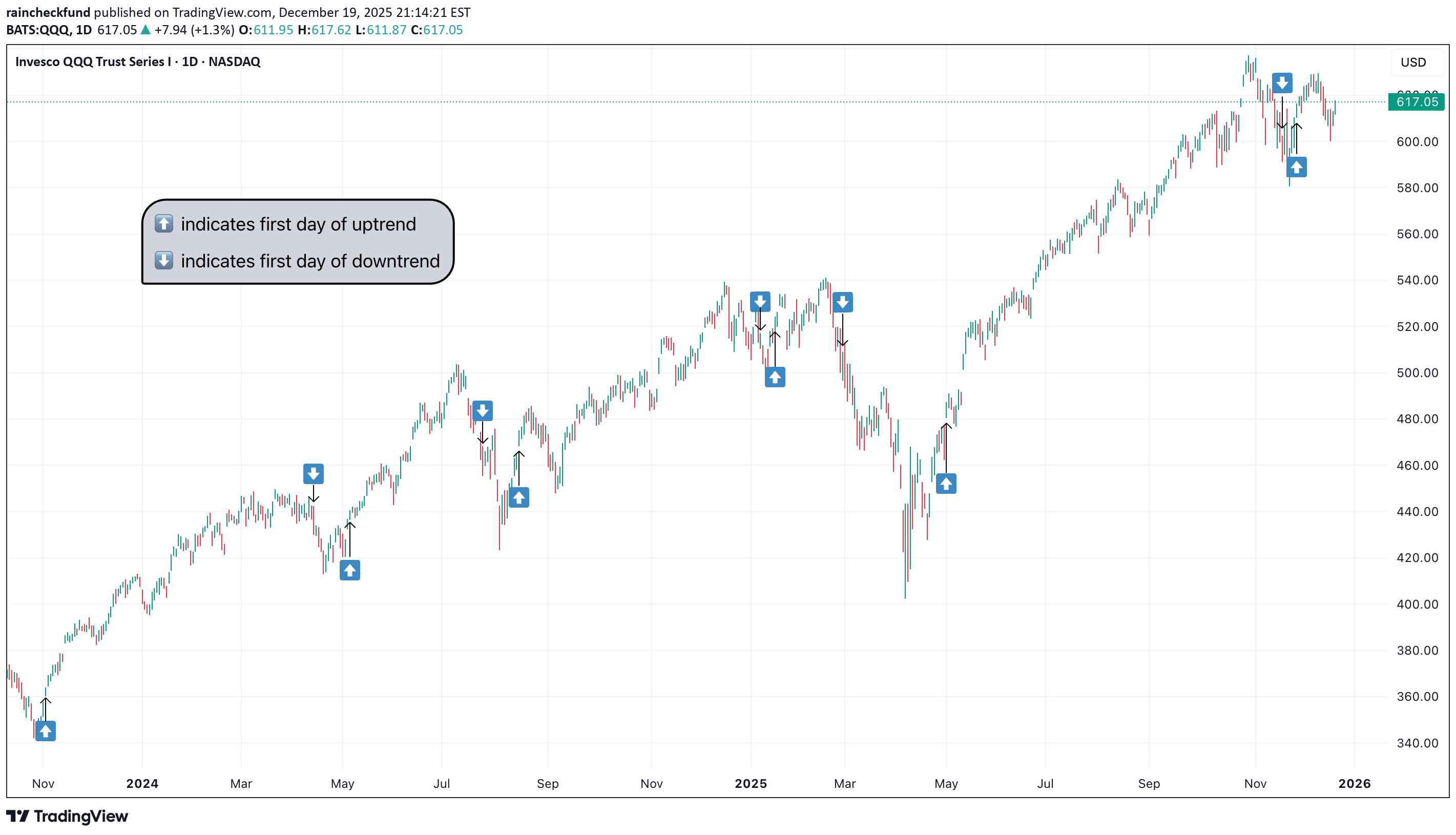
مارکت سیگنال الگوریتمی است که روندهای آماری در عملکرد قیمت QQQ و دارایی های آن را ارزیابی می کند تا تعیین کند که آیا QQQ در حال حاضر در یک روند صعودی (📈) یا نزولی (📉) است. هر روز پس از بسته شدن بازار، الگوریتم سیگنال بازار ما یک مقدار احساس بازار عددی را برمیگرداند که از -9 (نزولیترین) تا 9+ (بیشترین صعودی) متغیر است، که 0 یک امتیاز خنثی است. 📈 QQQ در طی روزهای متوالی ارزش سیگنال بازار مثبت در یک روند صعودی در نظر گرفته می شود. 📉 QQQ در طی روزهای متوالی ارزش سیگنال بازار منفی در یک روند نزولی در نظر گرفته می شود. نمودار تمام صفحه را ببینید -> tradingview.com/chart/nkwXX4Wx/

RonnieV29
Santa Rally / V-Shaped Recovery Watch
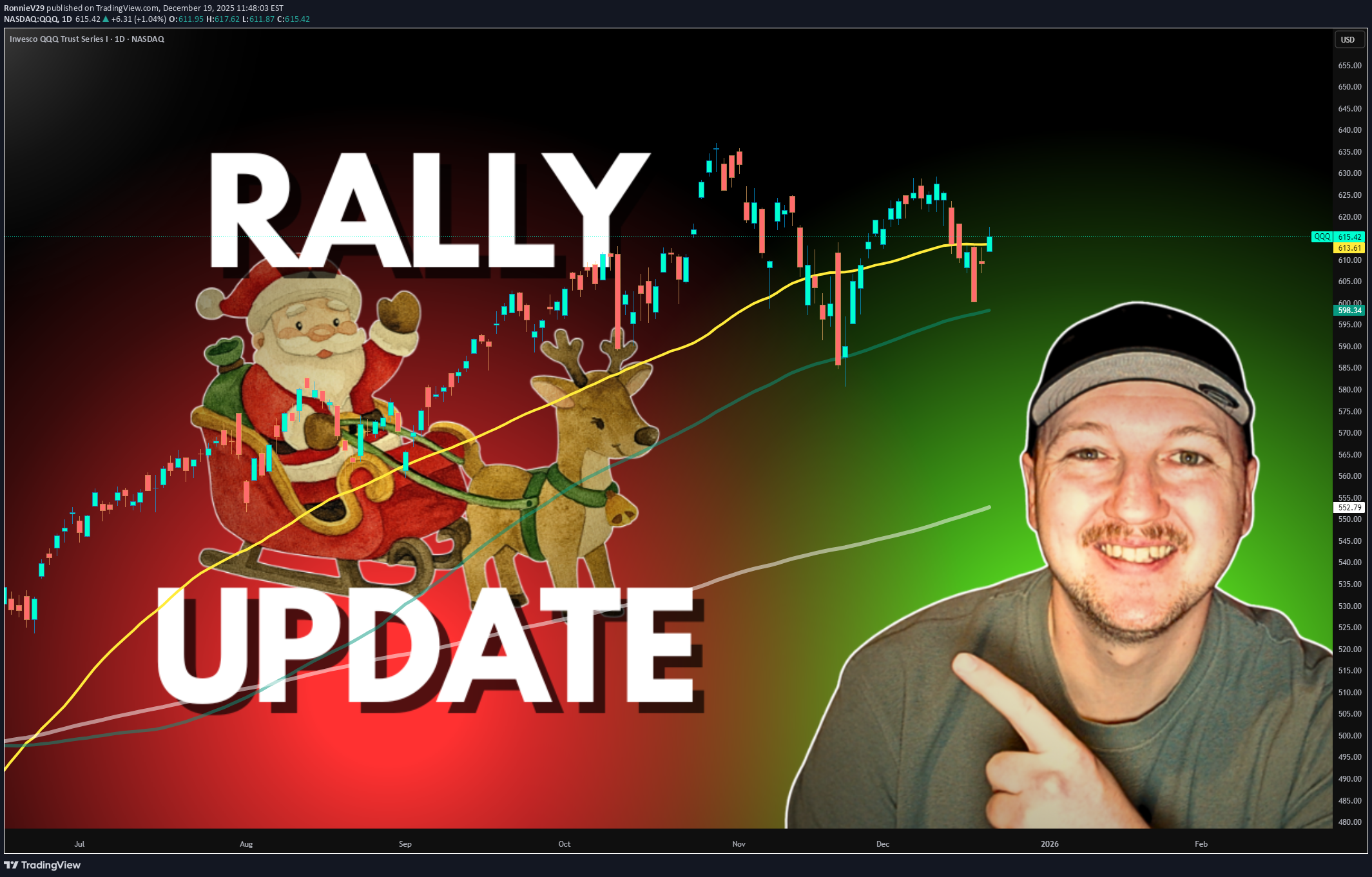
QQQ همچنان به 50 و 100 DMA احترام می گذارد، درست مانند هر فروش از جولای. اندیکاتورهای مومنتوم در حال خروج از قلمرو فروش بیش از حد هستند که نشان دهنده یک چرخش صعودی آشناست. جاسوس تایید می کند. IWM از نظر ساختاری در ماهانه (کاپ و دسته) صعودی باقی می ماند. BTC رفتار برگشت متوسط اشباع فروش کلاسیک را نشان می دهد. ریسک کلیدی: از دست دادن 100 DMA. تعصب: ادامه صعودی در حالی که پشتیبانی برقرار است.
Hello trader, for today, QQQQ is at 609.01 in real-time pre-mark
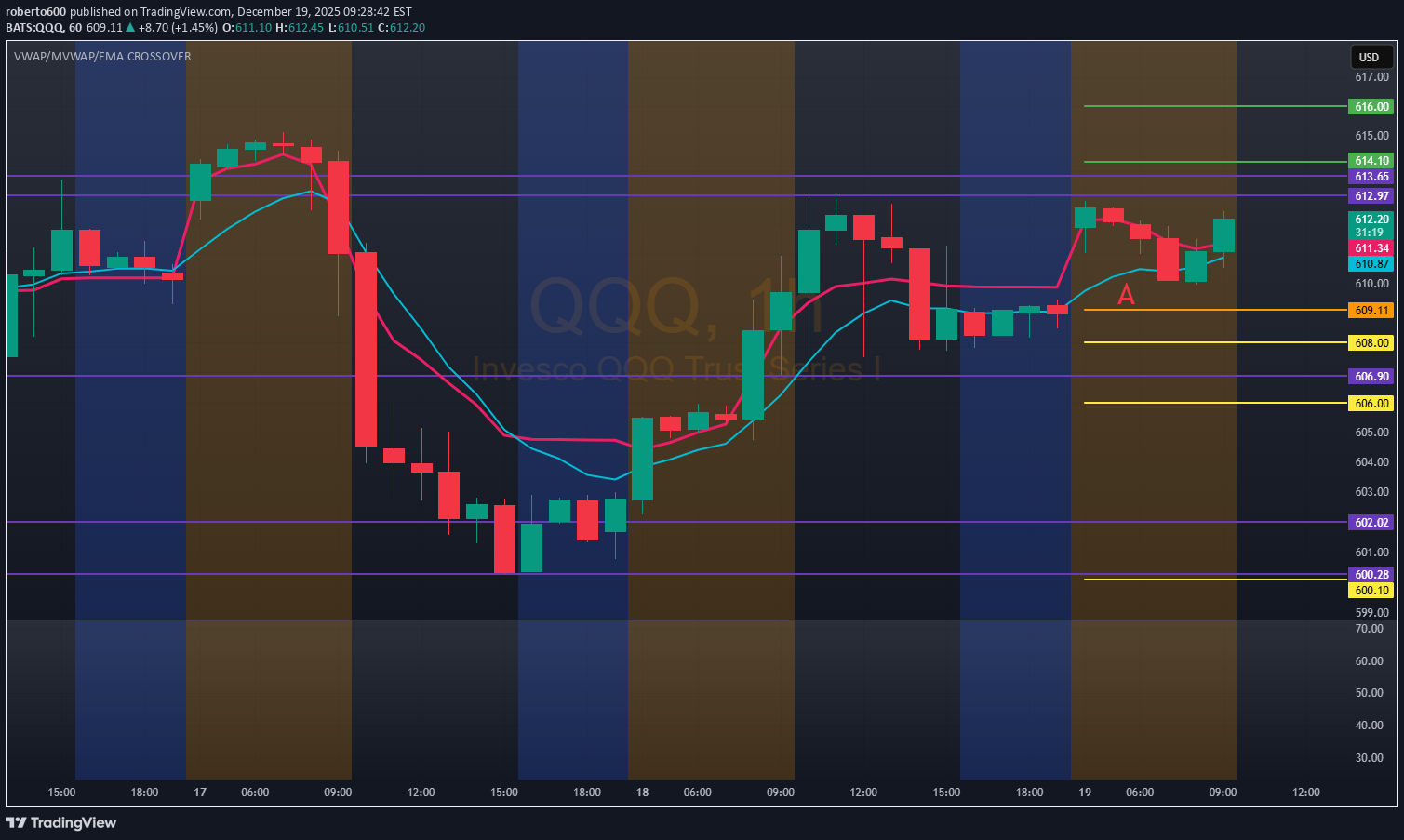
tradingview.com/chart/FvPElJ7r/ ورودی صعودی بالای 616.00 با پیش بینی احتمالی به ناحیه 628.00 بود. در غیر این صورت، ورودی نزولی ما باید زیر 606.00 باشد، که به طور بالقوه به منطقه 600.00 می رسد، که می تواند منطقه معکوس باشد. امروز جمعه است، پس باید مراقب تلههای بازار باشیم. روز معاملات خوبی داشته باشید.
Pitchfork up
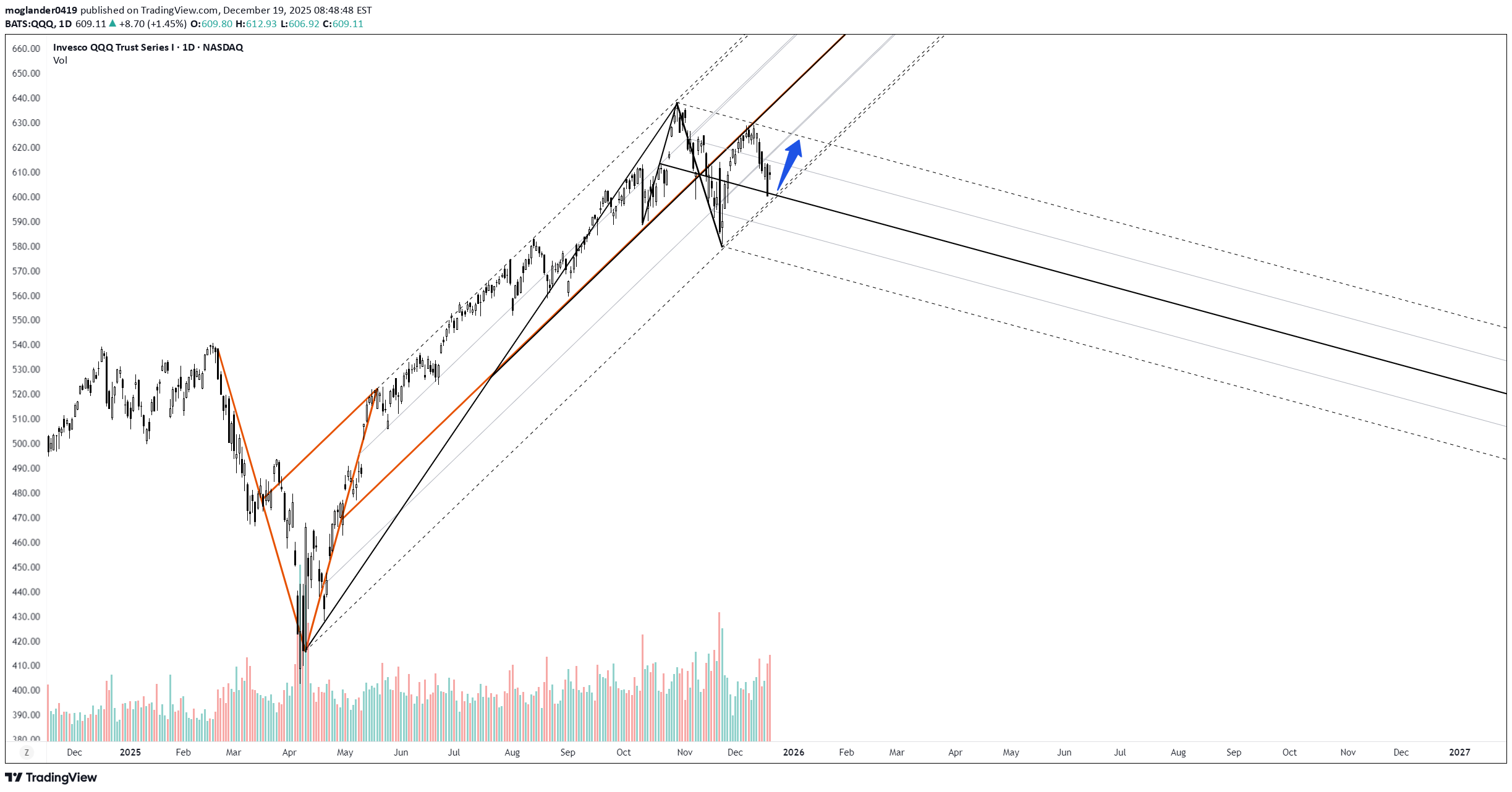
بازار باید در اینجا جهش کند. تجزیه و تحلیل Pitchfork جهش های متعدد را تایید کرد. چنگال های داخلی با استفاده از پاها در فوریه 2025، آوریل 2025، اکتبر 2025 و نوامبر 2025

RonnieV29
MASSIVE RALLY OR MASSIVE CRASH...
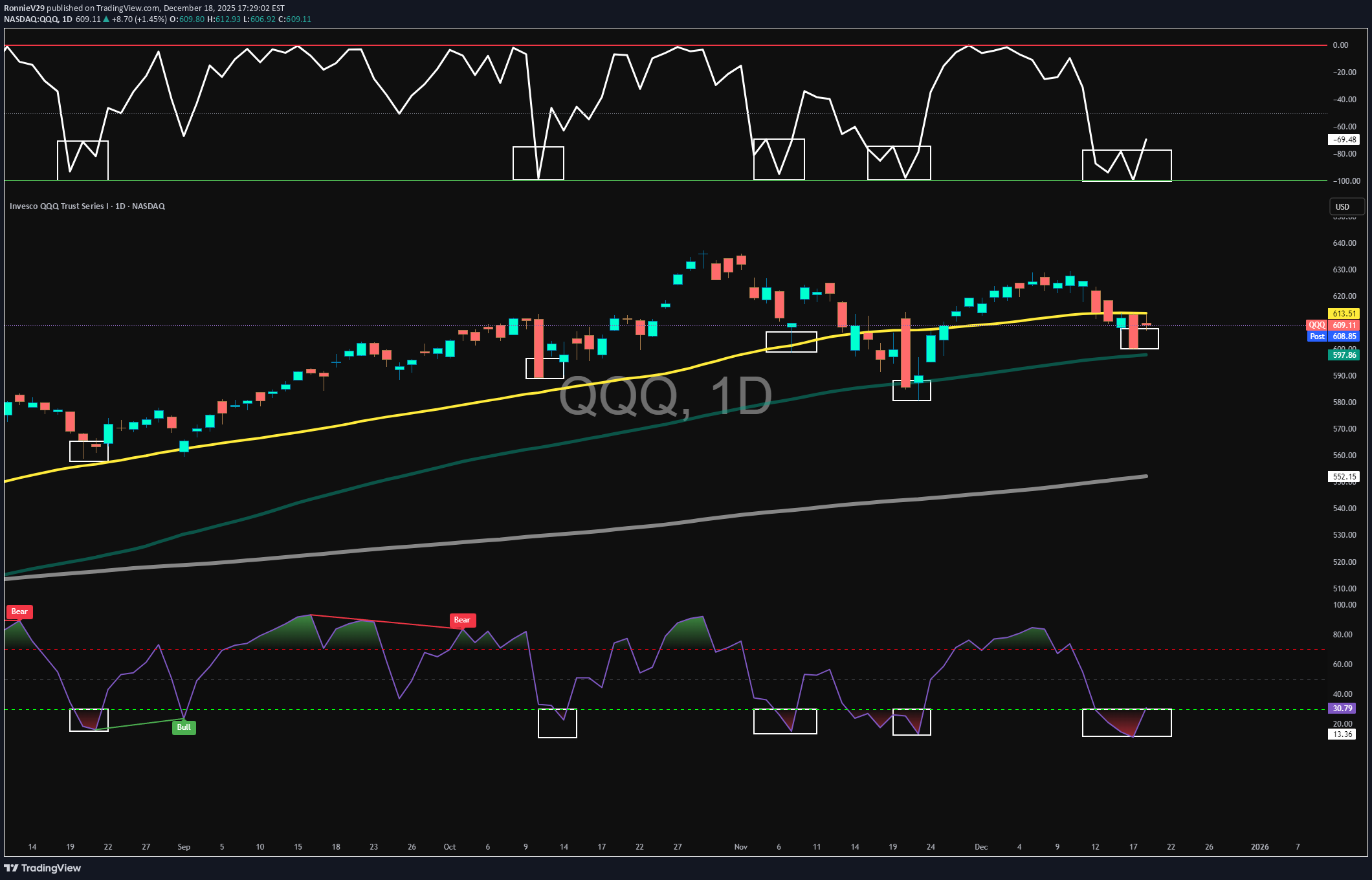
در این ویدیو در مورد اینکه آیا بازارها برای یک رالی عظیم یا تصادف عظیم صحبت می کنند ... QQQ جاسوس IWM
سلب مسئولیت
هر محتوا و مطالب مندرج در سایت و کانالهای رسمی ارتباطی سهمتو، جمعبندی نظرات و تحلیلهای شخصی و غیر تعهد آور بوده و هیچگونه توصیهای مبنی بر خرید، فروش، ورود و یا خروج از بازارهای مالی نمی باشد. همچنین کلیه اخبار و تحلیلهای مندرج در سایت و کانالها، صرفا بازنشر اطلاعات از منابع رسمی و غیر رسمی داخلی و خارجی است و بدیهی است استفاده کنندگان محتوای مذکور، مسئول پیگیری و حصول اطمینان از اصالت و درستی مطالب هستند. از این رو ضمن سلب مسئولیت اعلام میدارد مسئولیت هرنوع تصمیم گیری و اقدام و سود و زیان احتمالی در بازار سرمایه و ارز دیجیتال، با شخص معامله گر است.


